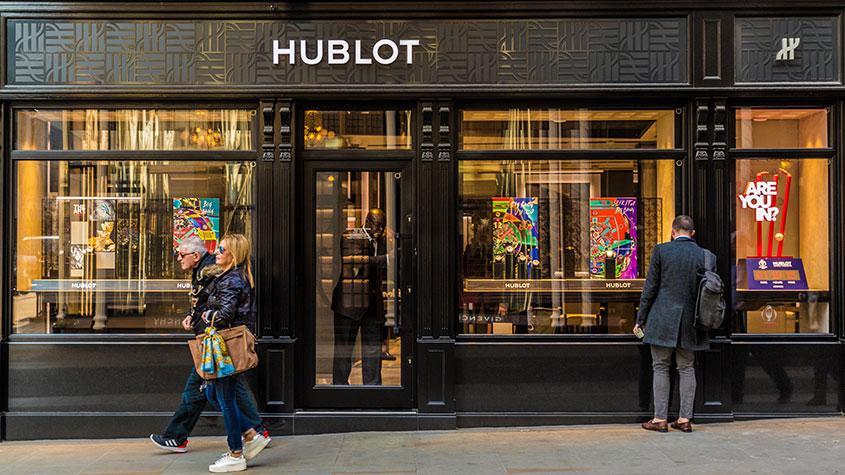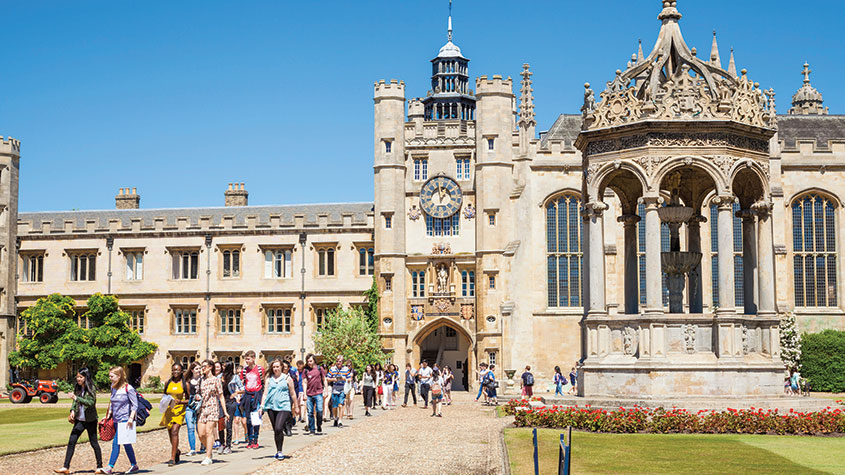Save on tax and save the planet: put some money in forestry
You can’t expect to find a magic money tree, but if you are a wealthier investor, then adding a forest to your portfolio could boost your returns – and it’s environmentally friendly too. David Prosser explores the options.


In turbulent political and economic times, many investors are attracted to physical, tangible assets that promise some sort of protection against inflation, upheaval in the financial system, or political change (or often, all three at once). Gold is one such "real asset"; property is another. But while most of us probably have some exposure to property, and many MoneyWeek readers will already own gold, there's one "real" asset you perhaps haven't considered forestry. Investing in woodland might sound like a hassle (it can be), or only for those who are aiming to pass their wealth to the next generation (it certainly has its uses on that front). But if you are looking to diversify your portfolio and plan to invest for the long run, it's an asset class that you shouldn't ignore.
Woodland covers around 13% of the UK, according to government statistics the best part of 3.2 million hectares. It's also attracting growing interest from institutional investors. These include the Church Commissioners, which manages the Church of England's investments, and has on its behalf built a portfolio of forestry worth around £250m. Forestry can provide both long-term income and capital growth. The income is generated by the sale of the timber felled each year the biggest customers come from the construction industry, but the paper and packaging business is a significant source of demand too. Growth, meanwhile, is driven by the rising capital value of the asset over time as timber prices rise, so do the value of the forests producing it.
What makes forestry particularly interesting though is that it tends to move in a different way from other assets so adding it to your portfolio should help you to reduce the risk of volatility without damaging your returns. "Investors like the fact that it is asset backed, low volatility and uncorrelated to mainstream listed equities and bonds, which makes it an excellent source of diversification," says Anthony Crosbie Dawson, an investment manager at Gresham House, owner of FIM, the country's biggest forestry manager. "Whatever else is going on in the world, whether it's Trump or Brexit, these trees go on growing and therefore adding more value." Indeed, between 2007 and 2017, according to Gresham House figures, UK timberland returns correlated most closely with the UK inflation rate (and even then, the correlation is just over 0.5 significant, but hardly moving in lockstep). The correlation with UK equities, meanwhile, was virtually non-existent.
MoneyWeek
Subscribe to MoneyWeek today and get your first six magazine issues absolutely FREE

Sign up to Money Morning
Don't miss the latest investment and personal finances news, market analysis, plus money-saving tips with our free twice-daily newsletter
Don't miss the latest investment and personal finances news, market analysis, plus money-saving tips with our free twice-daily newsletter
Tax breaks grow on trees
The past performance (which is, of course, no guide to the future, though it's the only one we have) of forestry has been impressive. The Investment Property Databank (IPD) UK Forestry index, which measures the performance of more than 100 plantations of Sitka spruce (the main source of UK timber), has delivered average returns of 11.6% and 9.2% a year over the past ten and 25 years respectively. That's well ahead of both equities and bonds over the same period. Moreover, for individual UK investors in commercial forestry, there's an additional bonus in the form of incentives that protect returns from the taxman. There's no income tax to pay on timber revenue and no capital-gains tax (CGT) on gains in the value of your timber any gains in the value of your land would be taxable, but it's the wood that accounts for most of the capital growth.
"If you want to diversify a long-term portfolio, don't ignore forestry"
On top of all that, forestry investments held for more than two years qualify for business property relief (BPR). This means your forestry investment can be passed on to your heirs free from inheritance tax (IHT). Given these advantages, many financial advisers and wealth managers now view forestry as a useful vehicle for tax-efficient investment planning. "Forestry is recognised as having low volatility and offers something of a safe haven, but the tax advantages are a real draw too," says Alex Davies, chief executive and founder of Wealth Club, which advises investors on tax-efficient investments.
Of course, all of these tax rules are subject to change, and you shouldn't let the tax tail wag the investment dog a duff investment is a duff investment. But it's worth noting that the tax advantages, assuming they remain in place, are likely to increase demand for forestry and widen its investor base. For example, the number of people caught in the IHT net looks set to rise significantly over the next five years the Treasury's IHT take broke through £5bn in 2017-2018 for the first time. And as the limits on annual pension contributions have grown ever-tighter particularly for those earning over £150,000 a year forestry could well benefit from higher demand for alternative tax-efficient vehicles from top earners, in the same way as venture capital trusts (VCTs) and enterprise investment scheme (EIS) funds have enjoyed a boost in recent years.
Be sure to choose a professional
For investors looking to capture these tax advantages, there are two options. One is simply to buy a piece of commercial forestry direct, perhaps managing the asset with the help of an expert adviser. However, this requires a substantial upfront investment: you can buy chunks of woodland for hobby or conservation purposes, but if you're looking at it as an investment, then experts suggest you need at least £1m to buy a forestry asset that is commercially viable.
The alternative is a specialist forestry fund offering exposure to a portfolio of assets run by a professional manager on your behalf. These funds typically operate like private-equity vehicles as limited partnerships that open for investment periodically, rather than listing shares or units on a secondary market. They're also classified by the Financial Conduct Authority as unregulated investments. This means the managers aren't allowed to promote them to the general public and that only certain types of investor, such as "high-net-worth" (HNWs) investors, can buy.
It's also important to note that should something go wrong with an unregulated investment, you won't be able to complain to the Financial Ombudsman Service or claim compensation from the Financial Services Compensation Scheme. There have been several scams in recent years involving forestry, including funds that have promised high returns from investments in developing markets that turned out to be frauds.So you need to be absolutely sure that you're only dealing with well-regarded forestry managers who have a proven record within the field.
"The UK's timber industry has a record of resilience"
It won't cost you £1m to get involved, but forestry funds do tend to have high minimum investments. FIM regularly raises money for timber funds (see the box on page 26 for more), but requires investors to commit around £90,000. Other funds are a little more accessible. Davies points to Par Equity's Forestry Fund, which is also in the market for new investors right now and quotes a minimum investment of £50,000. Stellar Asset Management, which offers forestry investment through its estate planning portfolio services, starts from a similar level of minimum investment.
But moving beyond the tax breaks and on to the investment case, what is the outlook for UK forestry? Davies points out that the UK's timber industry has a track record of resilience, with demand increasing in every year of the last decade, with the understandable exception of 2008, which was when the financial crisis caused credit markets to seize up and the world was plunged into recession. While timber imports did not recover until 2014, domestic volumes were back on an upwards trajectory by 2009. "Demand is largely driven by the construction industry, which is responsible for around 60% of timber consumption," notes Davies. "A decade ago, timber was only used structurally in buildings with less than two or three storeys and only one out of every six homes was built using timber frames; today, timber is used in buildings of up to six storeys and even higher, and one in three detached homes is built on a timber frame."
This will help growth in demand to continue, particularly as UK governments of all stripes continue to promise the building of more new houses. In the 2016-2017 financial year, some 217,000 houses were built in England alone. That was the highest volume seen since the financial crisis, but still well short of the government's target of 300,000 a year. There is also a trend to build more family homes rather than flats; the former require more timber per unit.
Brexit has been good news for forestry
"Globally, it's hard to see a scenario where there is no demand," agrees Paul Atkinson, a partner at Par Equity. "The demand for natural resources goes hand in hand with the growth in population, and therefore in building; certainly, previous downturns in the timber market have been short-lived in relation to the lifespan of a tree." Indeed, this is one of forestry's "secret weapons", as it were. Most agricultural crops perish unless harvested at a particular time, but the window of opportunity with trees is far wider. Sitka spruce is typically felled when trees are between 35 and 50 years old (older trees grow so high that the wind is more likely to blow them over). So if timber prices are weak at the intended time of felling, the manager can delay until a more favourable time.In effect, you just hang on for a better price, and while you wait your investment literally continues to grow.
Moreover, this is an industry where Brexit is providing a boost. The fall in the value of sterling against the euro means that UK-produced timber is now significantly cheaper than imported wood.While importers are paying around £207 for each cubic metre of timber coming from eurozone countries, the price in the UK is £167 a major advantage for domestic suppliers.
None of this is to suggest that forestry investment is a sure thing nothing is. Slower-than-expected construction-sector growth particularly if the UK economy stutters could be a brake on demand. Other consumers of timber, including newer industries such as the biomass-fuel sector, may provide a bit of a safety net here, but construction is the key customer for forestry owners and any slowdown in either the residential or commercial markets is bound to have an impact, at least in the short term.
"Brexit has made British timber much more competitive"
Other downside risks include the possibility of suffering losses from pests or disease; while forestry managers are able to insure their plantations against loss from fire (and in the British climate, these are thankfully relatively rare events in any case), they aren't able to buy protection from this sort of damage, though Sitka spruce is well-regarded as a hardy variety of tree. Another potential issue, concedes FIM's Anthony Crosbie Dawson, is that as we've noted already tax incentives are never guaranteed in perpetuity. "Changes in the reliefs are always a possibility," he warns. "There is nothing on the horizon that we've seen, but governments can and do change their views." It's something to bear in mind, particularly at a time when governments of all political stripes seem increasingly tempted to equate just about any form of tax efficiency with a failure to pay one's "fair share".
Always remember this is a long-term investment
It's also important to note that forestry is, of course, an illiquid investment (in other words, it's hard to get your money out once it's in). This is certainly the case if you're investing direct, but it's also an issue if you're in a limited partnership, where there is no immediate secondary market for your holding. While forestry fund managers will try to help you realise an investment if necessary, it may take time to sell and there are no guarantees about the price you'll secure.
For all of these reasons plus the unregulated nature of forestry funds and their high minimum investments this is not an asset class for the mass market. The limited supply of opportunities, in any case, prevents it from becoming so. But for those readers who have already filled up their individual savings accounts and pensions, and are looking at other tax-planning opportunities, such as VCTs and the EIS, forestry will potentially be attractive, particularly if you're also concerned about IHT.
There's also a certain romance in owning a piece of forest and at a time when "ESG" (environment, social and governance) and "impact" investing is all the rage, forestry benefits from being a sustainable and environmentally friendly investment. "Forestry as an asset class is an important part of the UK's commitment to the climate change agenda," says Atkinson. "When we fell trees, we replant even more, and we're sinking lots of carbon in the process." Portfolio diversification, an investment in real assets, and the chance to do some good who could resist? We look at ways into the sector below.
How to invest in forestry
If you decide to take the plunge and invest in forestry in the UK, there are a few ways to do so. You can take the most direct route, and buy your own plot of land. The Royal Institution of Chartered Surveyors (RICS) lists qualified chartered surveyors who can assist you with this. As noted above, you'll need to invest a significant amount of money to render any individual forestry investment viable on a commercial basis.
Alternatively, you could go to specialist asset manager Forestry Investment Management (FIM), which will help you to select the land and then manage it on your behalf, taking an agreed percentage of the net proceeds of timber sold. The minimum investment is generally from £3m upwards, so you do need to have a significant portfolio already in order to consider this option.
Much as it would be nice to be able to wander through your own timber forest, for most people buying forestry direct is simply too much to take on (though if you do want to buy a small recreational patch of woodland, there are several websites that specialise in this just don't think of the money spent as an investment). FIM does offer timber funds as an alternative. The minimum investment in its funds is around £90,000, and it plans on launching a new fund in the summer.
You can also invest in commercial forestry through asset manager Stellar's estate-planning services. Note that again, this doesn't come cheap the minimum you can invest is £40,000, and there is also an initial fee of 2%, an annual fee of 1%, an administration fee of 1%, and a performance fee of 20% for performance in excess of 5% a year.
If you're looking for a cheaper fund with a globally diversified portfolio, iShares' Global Timber & Forestry UCITS Exchange Traded Fund (LSE: WOOD) owns 23 forestry and timber companies, with 35% of its portfolio in the US, 13% in Canada, and nearly 5% in the UK. It is currently yielding 2.3%, has returned 68% over the past five years, and has a management fee of 0.65%. Just keep in mind that the portfolio is heavily weighted outside of the UK, and that the companies you are investing in will not all be pure timber companies some of them will be paper companies, for instance.
So while you do get some exposure to the sector in general, this sort of fund would sit in the equity part of your portfolio you shouldn't really think of it as a way to diversify. You also do notget any of the tax benefits of direct investment in forestry. That said, buying an ETF is by far the more liquid option.
An alternative ETF to consider is the US-listed Invesco MSCI Global Timber ETF (NYSE: CUT), whichyields 2.95% and has a management fee of 0.5%.Its five-year return is less impressive, at 21%, relative to 72% for the S&P Global Timber and Forestry index.
Get the latest financial news, insights and expert analysis from our award-winning MoneyWeek team, to help you understand what really matters when it comes to your finances.

David Prosser is a regular MoneyWeek columnist, writing on small business and entrepreneurship, as well as pensions and other forms of tax-efficient savings and investments. David has been a financial journalist for almost 30 years, specialising initially in personal finance, and then in broader business coverage. He has worked for national newspaper groups including The Financial Times, The Guardian and Observer, Express Newspapers and, most recently, The Independent, where he served for more than three years as business editor.
-
 PayPoint: A promising stock for income-seekers
PayPoint: A promising stock for income-seekersPayPoint, a household name across Britain, is moving away from its traditional roots toward a digital future. Investors after a steady income should buy in
-
 Invest in forestry: a tax-efficient way to grow your wealth
Invest in forestry: a tax-efficient way to grow your wealthRecord sums are pouring into forestry funds. It makes sense to join the rush, says David Prosser
-
 Invest in space: the final frontier for investors
Invest in space: the final frontier for investorsCover Story Matthew Partridge takes a look at how to invest in space, and explores the top stocks to buy to build exposure to this rapidly expanding sector.
-
 Invest in Brazil as the country gets set for growth
Invest in Brazil as the country gets set for growthCover Story It’s time to invest in Brazil as the economic powerhouse looks set to profit from the two key trends of the next 20 years: the global energy transition and population growth, says James McKeigue.
-
 5 of the world’s best stocks
5 of the world’s best stocksCover Story Here are five of the world’s best stocks according to Rupert Hargreaves. He believes all of these businesses have unique advantages that will help them grow.
-
 The best British tech stocks from a thriving sector
The best British tech stocks from a thriving sectorCover Story Move over, Silicon Valley. Over the past two decades the UK has become one of the main global hubs for tech start-ups. Matthew Partridge explains why, and highlights the most promising investments.
-
 Could gold be the basis for a new global currency?
Could gold be the basis for a new global currency?Cover Story Gold has always been the most reliable form of money. Now collaboration between China and Russia could lead to a new gold-backed means of exchange – giving prices a big boost, says Dominic Frisby
-
 How to invest in videogames – a Great British success story
How to invest in videogames – a Great British success storyCover Story The pandemic gave the videogame sector a big boost, and that strong growth will endure. Bruce Packard provides an overview of the global outlook and assesses the four key UK-listed gaming firms.
-
 How to invest in smart factories as the “fourth industrial revolution” arrives
How to invest in smart factories as the “fourth industrial revolution” arrivesCover Story Exciting new technologies and trends are coming together to change the face of manufacturing. Matthew Partridge looks at the companies that will drive the fourth industrial revolution.
-
 Why now is a good time to buy diamond miners
Why now is a good time to buy diamond minersCover Story Demand for the gems is set to outstrip supply, making it a good time to buy miners, says David J. Stevenson.